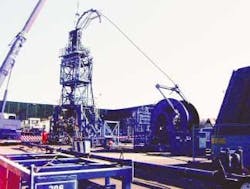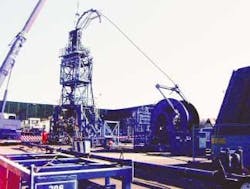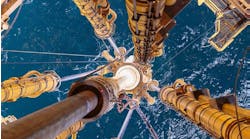Frank Hartley
Drilling/Production Editor
Nederlandse Aardolie Maatschappij (NAM), a Shell-ExxonMobil joint venture, has used drilling-using-coiled-tubing technology (DUCT) to drill an underbalanced horizontal extension to a producing well while cont-inuing production. NAM used coiled tubing technology provided by BJ Services Co. on the well, NAM's third in the Emmen field in the Netherlands.
The company drilled a 142-m horizontal section at a depth of 4,748 m (TMD) with a maximum measured temperature of 146° C. Throughout drilling and upon completion, the well produced natural gas at a rate of 500,000 cu m/day at a flowing tubing head pressure of 46 bar (674 psi). All operations relating to the underbalanced drilling on Emmen 8ST were completed in seven days.
BJ Services' drilling-using-coiled-tubing (DUCT) technology allowed underbalanced CT drilling in a producing well.
null
The technology used in the operation for NAM and two wells drilled earlier this year using DUCT technology will be exported globally, according to Alasdair Buchanan, BJ Services regional manager – Europe & Africa, Well Services Division. The technology is significant to the industry because it can be deployed with the BHA under pressure in a safe, efficient manner, which is critical when drilling underbalanced, and especially so when drilling underbalanced in the presence of H2S gas, he said.
First international application
Although DUCT technology has been used extensively in Canada, the three operations in Holland mark the first comprehensive international application. Previously, the company drilled two onshore wells in the Coevorden field in the Netherlands using DUCT technology on behalf of NAM. A team of about 70 individuals from five countries collaborated to drill the Coevorden 17b well, followed by the Coevorden 16. The first project involved drilling a 1,650-ft (500-m) horizontal section in a naturally fractured carbonate formation with a bottom hole pressure of 4,800 psi (326 bar) and temperature of 220° F (104° C). The project management personnel, deployment experts, and BHA specialists provided hands-free pressure deployment technology for the custom BHAs developed in-house.
DUCT equipment
The base in Emmen, The Netherlands, provided the CT drilling unit, mast structure, pump systems, and the operational team to run both the CT and pumping equipment. The onsite CT UB drilling engineering team was made up of staff from Canada and The Netherlands.
The BHA team incorporated the following:
- Real time MWD
- Real time gamma ray (LWD)
- Real time bottomhole temperature and pressure sensors
- Real time drilling sensors to monitor motor performance
- 400° electric-over-hydraulic orienting system that can provide up to 1500 psi torque to enable on-bottom orienting.
Communication with the BHA is achieved through a seven-conductor cable installed inside the coiled tubing. The BHA, which has a maximum outside diameter at the tool joints of 3 3/8-in. (85.73 mm), has been used to drill holes from 3 3/4-in. (95.25 mm) to 6 1/8-in. (155.58 mm). The complete BHA has a typical length of 19-20 m, depending on motor and bit selection.
As the wells were drilled underbalanced, the BHA had to be deployed in and out of the hole under live sour gas conditions. The team employed an in-house-developed hands free deployment system that uses a universal connect disconnect (UCD) connector in combination with a custom BOP. During deployment, the UCD connector is located inside the custom BOP, which is installed on top of the well control BOP. A chamber is created that can be pressurized from the outside, and the connector functions by pressure differential. The system is a key element in the safe retrieval of BHAs from sour gas wells.
Work reels suitable for the CT length of 14,435 ft (4,400 m) and 2 3/8-in. size were mobilized to the location with a 10,000-psi BOP stack. Crews from Canada and The Netherlands drilled the wells underbalanced using KC1 brine co-mingled with nitrogen.
Challenging conditions
Natural gas production began shortly after drilling into the first fracture system on Coevorden 17b and increased with each subsequent natural fracture encountered. The team decided to terminate drilling after 580 ft (176 m) and performed drilling and deployment operations with high surface gas rates and flowing tubing head pressures of 4,000 psi (272 bar).
Two lateral sections were drilled for the second well, Coevorden 16. One extended 1,729 ft (524 m) and the other 1,128 ft (342 m). The second lateral was drilled without tripping out of the hole with the same BHA used to drill the first lateral. The well flowed gas during drilling and deployment, with up to 1,500 ppm of sour gas. All operations were performed in a live well environment with returns handled by The Expro Group.
The third well presented additional challenges. Formation parameters tested the limits of technology by depth, temperature, and bottom hole pressure. As a result, weight on bit, BHA function, and cuttings transport were closely monitored.
The three-well operation was managed with a total of 3,885 ft (1,184 m) drilled. Bob Fraser, BJ team leader for coiled tubing drilling engineering, and Ken Hall, BJ/NAM senior project engineer, were cited by NAM as providing notable contributions to the success of the project. The overall project management was conducted in-house by NAM.




